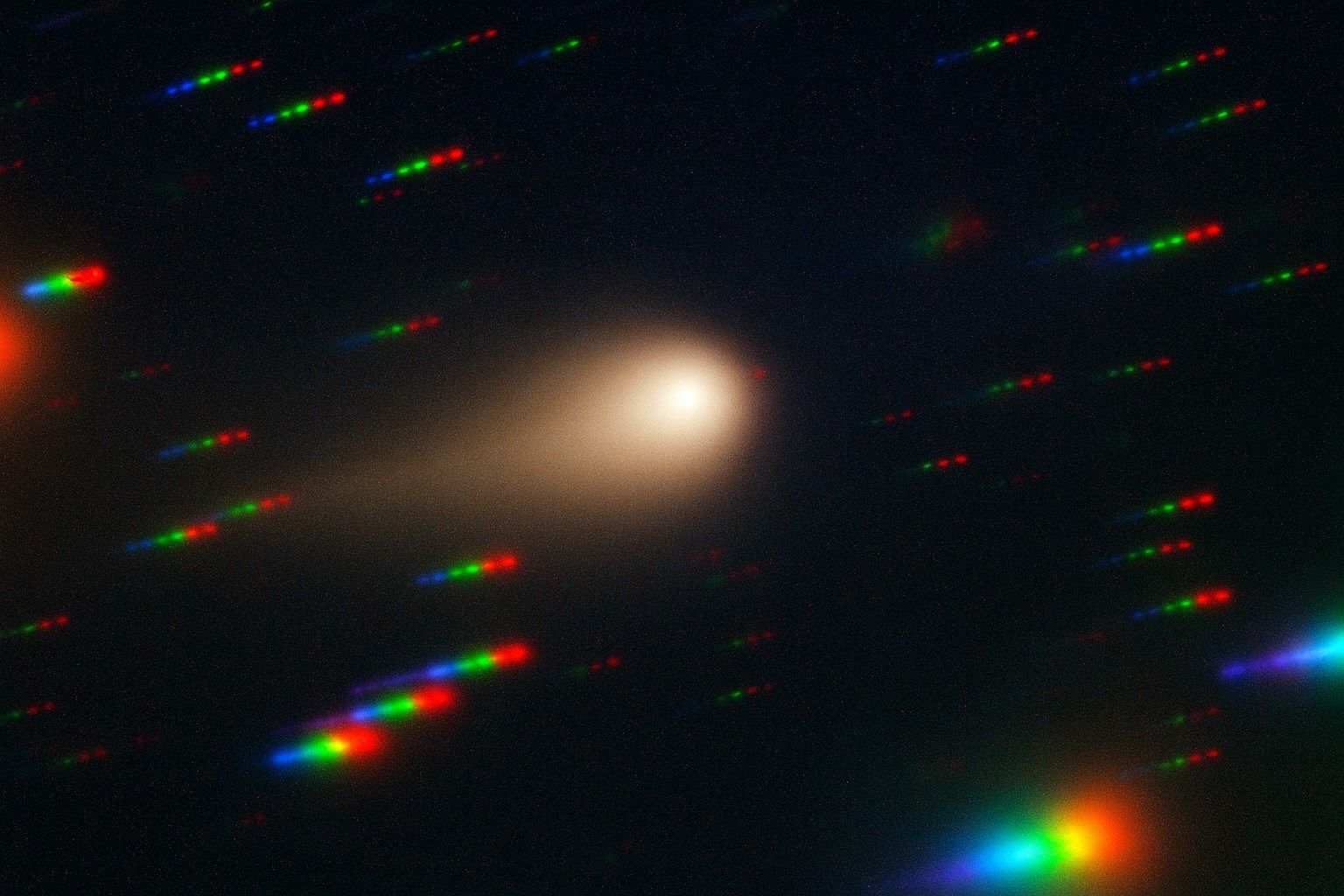Key points
- First fresh images since solar conjunction: The Virtual Telescope Project released a new photo of interstellar comet 3I/ATLAS taken today, Nov. 5, as the object reenters before‑dawn skies. [1]
- Chemistry surprise from JWST: Early results point to a CO₂‑rich coma and a 15–20‑meter irradiation crust likely carved by galactic cosmic rays over billions of years. [2]
- Water activity confirmed: NASA’s Neil Gehrels Swift Observatory detected OH—the UV fingerprint of water—indicating active water outgassing at large distance from the Sun. [3]
- Behavioral oddities continue: Reports since perihelion include a blue color shift and possible course/brightness changes being analyzed by researchers. [4]
- No hazard to Earth: NASA affirms 3I/ATLAS is a one‑time interstellar visitor on a hyperbolic path; its closest Earth approach (~1.8 AU) comes Dec. 19, 2025. [5]
What’s new today (Nov. 5)
After weeks hidden in the Sun’s glare, 3I/ATLAS is being picked up again by ground telescopes. The Virtual Telescope Project published a clean, post‑conjunction image captured this morning (UTC), marking the start of a new observing window as the comet climbs into darker, pre‑dawn skies. The team plans additional public sessions as conditions improve. [6]
At the same time, science teams are digesting a flurry of perihelion‑time findings. Analysts note the object’s distinct blue hue reported in recent imagery—its third apparent color shift since discovery—and are comparing that trend with gas‑driven activity seen by space‑based monitors during conjunction. [7]
Separate coverage today highlights small trajectory adjustments and possible mass loss inferred from new measurements, though scientists caution that such changes are common in active comets and will be vetted as more post‑conjunction data arrive. [8]
A quick refresher: what is 3I/ATLAS?
Designated 3I/ATLAS (C/2025 N1), the object is only the third confirmed interstellar visitor ever observed passing through our solar system, after 1I/ʻOumuamua (2017) and 2I/Borisov (2019). Its hyperbolic orbit proves it came from beyond the Sun’s gravitational grasp—and that it will leave for interstellar space once again. [9]
Hubble imaging in July set a tighter upper limit on the nucleus size—≤ 3.5 miles (5.6 km)—though the core itself remains shrouded by dust and gas. The same campaign documented a teardrop‑shaped dust cocoon and tail, confirming classic cometary behavior. [10]
Safety note: NASA reiterates that 3I/ATLAS poses no threat to Earth. Its closest Earth approach is projected for Dec. 19, 2025, at roughly 1.8 AU (~270 million km)—nearly twice the Earth–Sun distance. [11]
What the big observatories are seeing
JWST & SPHEREx: a CO₂‑dominated coma and an “aged” surface
Early spectroscopy led by JWST’s NIRSpec points to a CO₂‑rich coma (with CO and H₂O also present) and supports a picture in which galactic cosmic rays have converted CO to CO₂ and built up an irradiated crust tens of meters deep. The implication: today’s outgassing largely samples processed outer layers, not pristine interior ices—at least for now. As solar heating erodes that crust post‑perihelion, deeper material could be exposed. [12]
Swift (NASA): water activity at long range
Using the Neil Gehrels Swift Observatory, astronomers detected OH at 308.5 nm, a proxy for water vapor, when the comet was still far from the Sun. That early water activity—unusual at such distances—adds to the case that 3I/ATLAS is volatile‑rich and dynamically lively. [13]
During conjunction: rapid brightening from space‑based eyes
While the comet was hidden from Earth‑based telescopes, solar‑monitoring spacecraft recorded rapid, gas‑driven brightening. Those observations, together with the now‑blue appearance reported by multiple outlets, are being folded into post‑perihelion models. [14]
Why the “color changes” matter
Multiple teams have remarked on apparent color shifts—from reddish tints to greenish and now bluish tones. In comets, color mainly reflects the balance of dust vs. gas emissions: dust tends to redden, while emissions from species such as CN, C₂, CO⁺ can skew green/blue. Post‑conjunction brightness and color trending toward the blue likely means we’re seeing gas‑dominated activity, consistent with JWST’s CO₂‑rich picture. Researchers will test that hypothesis as more spectra arrive. [15]
Transparency push and politics: calls to release Mars‑side images
With interest spiking, lawmakers and scientists are pressing for the release of all high‑value observations—especially HiRISE images reportedly taken by NASA’s Mars Reconnaissance Orbiter during the comet’s early‑October Mars flyby. NASA experts are scheduled to brief at least one member of Congress this week, amid public appeals from researchers to publish more raw data. [16]
One widely read report today describes a U.S. representative urging NASA to release those Mars‑side assets; the agency has not announced any change in its data‑release cadence. As always, extraordinary claims about the comet’s nature remain unproven, and the scientific consensus continues to treat 3I/ATLAS as a natural comet pending peer‑reviewed evidence to the contrary. [17]
Timeline: where 3I/ATLAS is headed next
- Perihelion (closest to the Sun): ~Oct. 29–30, 2025 (inside Mars’s orbit). [18]
- Post‑conjunction reappearance: now underway (first new ground‑based image today). [19]
- Closest to Earth:Dec. 19, 2025 (~1.8 AU). Expect the easiest ground‑based viewing window to run from mid‑November into December (weather and Moon permitting). [20]
- Outbound leg: a Jupiter‑space pass in March 2026, then off into interstellar space for good. [21]
How to see 3I/ATLAS in the coming weeks
- When: About 60–90 minutes before local sunrise, beginning now and improving through mid‑ to late‑November as it climbs higher. Peak convenience for amateurs is expected late Nov. into December. [22]
- Where: Low in the eastern to northeastern sky before dawn; exact position shifts nightly. (Interactive charts and real‑time coordinates are available from TheSkyLive.) [23]
- What you’ll need: A moderate to large amateur telescope; most estimates keep peak brightness near magnitude ~11–12, below naked‑eye and binocular visibility under typical skies. [24]
- Pro tip: Follow professionals’ lead—astronomer Qicheng Zhang captured the first post‑conjunction optical image Oct. 31 with a major facility; backyard observers should temper expectations and use star charts or planetarium apps synced to JPL Horizons ephemerides. [25]
Why this matters scientifically
3I/ATLAS offers a one‑of‑a‑kind sample of solids and ices formed around another star. The CO₂‑rich, radiation‑processed surface seen by JWST suggests that long interstellar sojourns rework comet exteriors, meaning today’s gases may not represent the body’s original chemistry. As the Sun’s warmth strips the outer shell, scientists hope to peek deeper—and perhaps compare unprocessed material with comets born in our own protoplanetary disk. [26]
Quick facts
- Discovery: July 1, 2025, by the NASA‑funded ATLAS survey in Chile. [27]
- Speed: ~130,000 mph (≈209,000 km/h), among the fastest solar‑system visitors on record. [28]
- Size: Hubble’s upper‑limit diameter ≤ 5.6 km (could be smaller). [29]
- Closest Earth approach:Dec. 19, 2025 (~1.8 AU). [30]
- Status:Natural comet on a hyperbolic (one‑and‑done) trajectory. [31]
FAQ
Is 3I/ATLAS dangerous?
No. Its closest approach to Earth is ~1.8 AU on Dec. 19, 2025—nearly twice our distance from the Sun. [32]
Why did it look blue near the Sun?
Color in comets depends on whether gas emissions or dust dominate. Reports of a blue tint likely point to gas‑heavy outgassing, consistent with a CO₂‑rich coma seen by JWST. [33]
Did it really change course?
Small non‑gravitational nudges from jetting gases can tweak comet paths. Recent coverage notes minor shifts and mass loss, now being checked against post‑conjunction astrometry and models. [34]
Where can I follow live views?
The Virtual Telescope Project has resumed imaging and plans live sessions as the comet climbs higher before dawn. [35]
Sources & further reading
- Virtual Telescope Project: first post‑conjunction image (Nov. 5, 2025). [36]
- NASA Science: mission overview & safety/visibility timeline; Hubble size estimate. [37]
- JWST/Research: CO₂‑dominated coma and cosmic‑ray processed crust. [38]
- Swift (NASA): OH detection (water activity) and explainers. [39]
- Live coverage: color shifts; brightening during conjunction. [40]
- Closest‑approach confirmations: ESA FAQ; EarthSky; Planetary Society; TheSkyLive ephemerides. [41]
- Policy context: U.S. government briefings and calls for additional data release. [42]
References
1. www.virtualtelescope.eu, 2. arxiv.org, 3. arxiv.org, 4. www.livescience.com, 5. science.nasa.gov, 6. www.virtualtelescope.eu, 7. www.livescience.com, 8. www.iflscience.com, 9. science.nasa.gov, 10. science.nasa.gov, 11. science.nasa.gov, 12. arxiv.org, 13. arxiv.org, 14. www.livescience.com, 15. www.livescience.com, 16. defensescoop.com, 17. nypost.com, 18. science.nasa.gov, 19. www.virtualtelescope.eu, 20. www.esa.int, 21. www.universetoday.com, 22. theskylive.com, 23. theskylive.com, 24. en.wikipedia.org, 25. www.livescience.com, 26. arxiv.org, 27. science.nasa.gov, 28. apnews.com, 29. science.nasa.gov, 30. www.esa.int, 31. science.nasa.gov, 32. science.nasa.gov, 33. www.livescience.com, 34. www.iflscience.com, 35. www.virtualtelescope.eu, 36. www.virtualtelescope.eu, 37. science.nasa.gov, 38. arxiv.org, 39. arxiv.org, 40. www.livescience.com, 41. www.esa.int, 42. defensescoop.com










